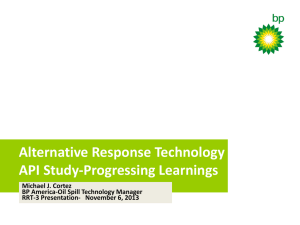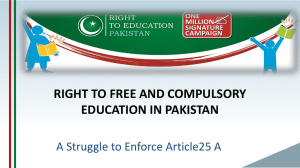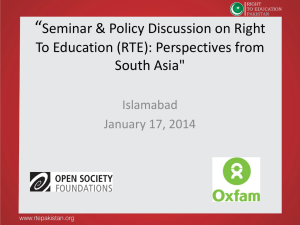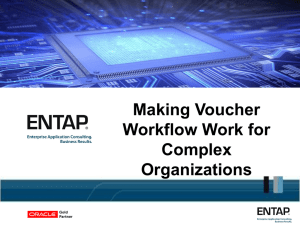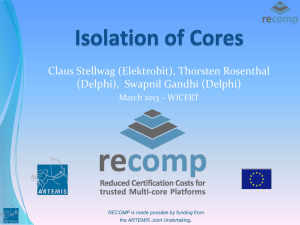Right to Education 2009: Indicators for Monitoring the Implementation
advertisement
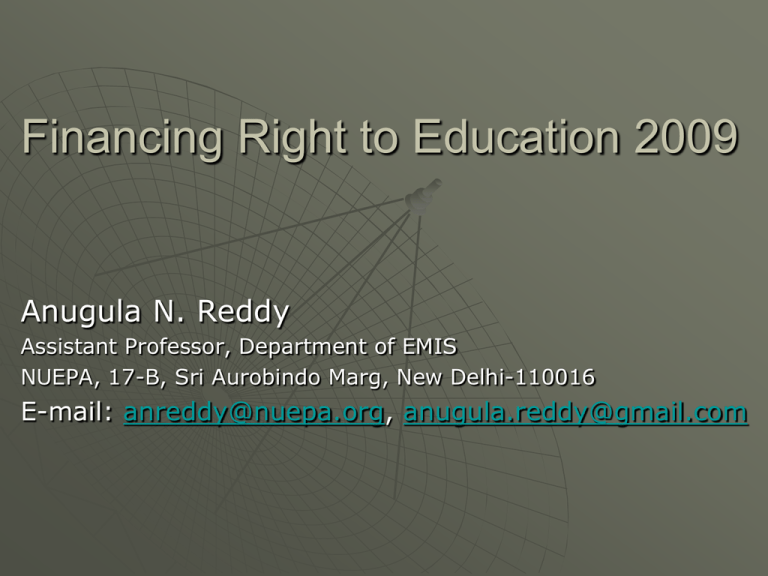
Financing Right to Education 2009 Anugula N. Reddy Assistant Professor, Department of EMIS NUEPA, 17-B, Sri Aurobindo Marg, New Delhi-110016 E-mail: anreddy@nuepa.org, anugula.reddy@gmail.com RTE-2009: A Culmination of Long Journey Provision of Free and Compulsory Education to All Children till Fourteen Years of Age as Directive Principle of Constitution (Article 45) Inadequate quantitative expansion, deteriorating infrastructure, declining quality, persistent inequalities Though many norms and parameters were specified to realize the provision of Free and Compulsory Education but these lack legal sanctity No mechanism to monitor the implementation and progress RTE-2009: A Culmination of Long Journey The Unnikrishnan Judgment delivered by supreme court of India galvanized the efforts to universalize elementary education and put it as high priority agenda in policy debates Following Unnikrishnan judgment the civil society put enormous pressure on Government to amend the Constitution to make elementary education a fundamental right in its own right Relenting to the pressures the Government of India amended the Constitution to make elementary education a right of children aged 6-14 years (Article 21 (A) The right shall come into force from the date of notification of an Act specifying various aspects of provision of free and compulsory education. RTE 2009 was enacted and implemented from April 2011 RTE-2009: A Culmination of Long Journey The Act purportedly intended to specify norms and standards and targets with regard to provision of Free and Compulsory Education However many of them left to be defined by appropriate authorities (provincial governments, local authority or professional bodies) or imprecisely defined • Definition of school –schedule but items can be added or deleted through an executive order • Definition of teacher and qualifications to become teacher by NCTE • Adequacy teaching learning material available in school, etc Financing RTE Financing universal elementary education as a fundamental right requires paradigm shift • The state can no longer take excuse of scarcity of resources, fiscal capacity, etc • This raises questions particularly how to determine the adequacy of resource • Shifts in criteria from financing from equity to adequacy (in US) – linking with outputs Financing RTE Criterion to Examine the Adequacy of Resource allocation to UEE • Proportion of GDP/GNP • Policy Recommendations like Kothari Commission recommendation to allocate public resources to education to the tune of 6 per cent of GNP; which was reiterated nearly by all committees subsequently • Latest policy recommendations to apportion 3 per cent of GNP to universal elementary education, 1.5 per cent to secondary education and the remaining 1.5 per cent to higher and technical education (Majumdar Committee, 1999, 2005; CABE Financing RTE Norm Based Criteria (Majumdar 1999, CABE Committee on RTE 2005, NUEPA 2009) • Resource requirements may be estimated by different components of RTE – warding off dilution of commitments • The Estimated resource requirements can be used to safeguard any dilution of norms and standards specified in the Schedule of the Act and items. Financing RTE Criterion to Examine the Adequacy of Resource allocation to UEE • Estimating Resource requirements on the basis of norms of RTE Taking stock of current status, identify gaps and resource required to fill the gaps Estimating-Total, Item wise, State wise, Central and State Shares Financing RTE Some estimates • Rs. 1200 thousand million over 10 years constituting a little over 3 per cent of GNP (Majumdar committee 1999) • Over Rs 2000 to 4000 thousand million over five years constituting about 3 to 3.5 per cent of GNP (CABE Committee, 2005) • About Rs. 2000 million over five years constituting less than 3 per cent of GNP (NUEPA, 2009) The 3% GNP arrived by various committees may be bottom-line-any additional resources required may have to be allocated from budget other than without cutting other levels of Financing RTE Some tensions • Federal Relations All layers of government are responsible Central Government to estimate resource requirements from time to time Central Government to refer to President to include allocations to RTE under Finance Commission and decide a formula to share resource burden with provincial governments in consultation Financing RTE Some Tensions Notwithstanding above the Act places the entire responsibility squarely on provincial government Limited capacity of provincial government and constrained by Acts relating to budgetary deficit As several components are left to be defined by appropriate authorities, these dilute the commitments subsequently • Financing through cess-Less support from general budgetary support Per cent of GNP to Education 4.50 4.00 3.50 3.00 2.50 2.00 1.50 1.00 Elementary Education Education As per cent Total Budget 15.5 15.0 14.5 14.0 13.5 13.0 12.5 12.0 11.5 11.0 10.5 10.0 9.5 9.0 8.5 8.0 7.5 7.0 6.5 6.0 5.5 5.0 4.5 4.0 education Elementary Education 1990- 1991- 1992- 1993- 1994- 1995- 1996- 1997- 1998- 1999- 2000- 2001- 2002- 2003- 2004- 2005- 2006- 2007- 200891 92 93 94 95 96 97 98 99 2000 01 02 03 04 05 06 07 08 09 RE
